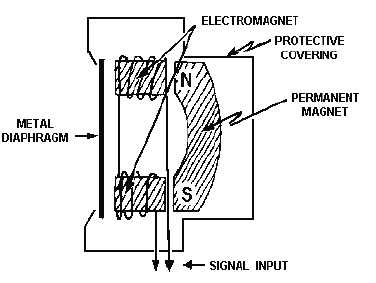2-32
Figure 2-32 shows a diagram of typical headphones used with Navy equipment. The device consists
of a permanent magnet and two small electromagnets through which the signal currents pass. A soft iron
diaphragm is used to convert the electrical effects of the device into sound power. When no signal
currents are present, the permanent magnet exerts a steady pull on the soft iron diaphragm. Signal current
flowing through the coils mounted on the soft iron pole pieces develops a magnetomotive force that either
adds to or subtracts from the field of the permanent magnet. The diaphragm thus moves in or out
according to the resultant field. Sound waves are then reproduced that have an amplitude and frequency
(within the mechanical capability of the reproducer) similar to the amplitude and frequency of the signal
currents.
Figure 2-32.—Headphone.
As compared to permanent magnet speakers, standard headphones are considered to be high-
impedance devices. Headphone electromagnets are normally wound with many turns of small wire, which
provide the larger impedance. Because of the physically small size and inflexibility of the metal
diaphragm, the headphones often give poor response to the lower audio frequencies. In the voice range of
audio, most standard issue headphones are adequate.
SUMMARY
In this chapter you learned transmitter and receiver fundamentals. We also discussed modes of
operation and special controls circuits. Let’s review some of these areas.
A HARMONIC is an exact multiple of the fundamental frequency. Even harmonics are 2, 4, and so
on, times the fundamental. Odd are 3, 5, and so on, times the fundamental frequency.
A SUBHARMONIC is an exact submultiple of the fundamental frequency. Even subharmonics are
one-half, one-quarter, and so on. Odd subharmonics are one-third, one-fifth, and so on, of the
fundamental frequency.
SUPPRESSION is the process of eliminating an undesired portion of a signal.



